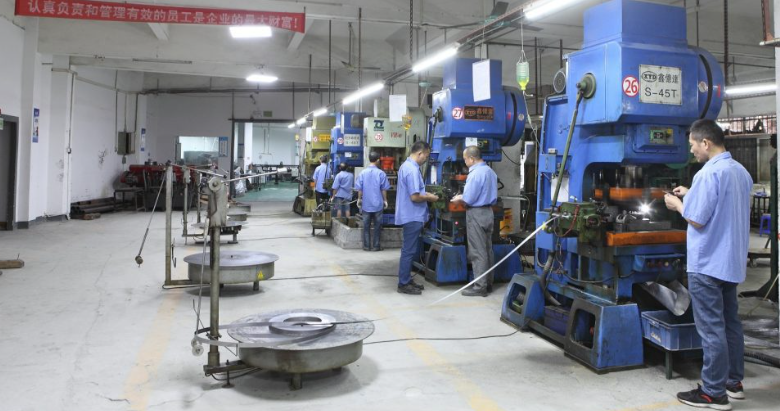Selecting a Reliable Metal Stamping Parts Manufacturer

Introduction to Metal Stamping Parts
Metal stamping is an essential process in modern manufacturing that transforms flat sheets of metal into functional and precise components. Components produced by metal stamping are widely used in automotive, aerospace, electronics, and industrial machinery. Partnering with an experienced metal stamping parts manufacturer ensures consistent quality, efficient production, and the ability to handle complex custom designs.
The Metal Stamping Process Explained
The process starts with feeding a metal sheet into a stamping press, where a die applies pressure to shape or cut the material. Operations such as bending, punching, blanking, coining, and embossing are commonly used to achieve the desired form. Depending on production requirements, a manufacturer may utilize single-station, progressive, or transfer stamping processes to maximize efficiency and maintain precision.
Advantages of Working with a Metal Stamping Parts Manufacturer
High Precision and Consistency
One of the primary benefits of metal stamping is its ability to produce parts with high accuracy and tight tolerances. This is particularly metal stamping parts manufacturer critical in industries where components must fit together precisely, such as automotive assemblies, electronic devices, and machinery. High precision reduces assembly errors and ensures reliability in the final product.
Cost-Effective Production
Metal stamping is cost-efficient for high-volume manufacturing. After the initial die design and production, large quantities of parts can be created rapidly, reducing labor and material costs. This makes metal stamping a practical choice for businesses looking to scale production while maintaining competitive pricing.
Versatile Material Options
A metal stamping parts manufacturer can work with a variety of metals, including steel, stainless steel, aluminum, brass, and copper. The choice of material is determined by factors such as strength, corrosion resistance, and application-specific requirements. This versatility allows manufacturers to provide tailored solutions for different industries.
See also: Unlocking Bookkeeping Secrets for Business Growth Tech Trends Gfxprojectality
Key Applications of Metal Stamping Parts
Automotive Industry
In automotive manufacturing, metal stamping parts are essential for components such as brackets, body panels, engine parts, and structural reinforcements. The precision and durability of stamped components contribute to vehicle safety, performance, and longevity.
Electronics and Electrical Applications
Metal stamping is used to produce connectors, terminals, enclosures, and heat sinks for electronic devices. Accurate stamping ensures reliable electrical connections and supports compact design requirements in modern electronics.
Industrial Machinery and Equipment
Industrial machinery and construction equipment frequently rely on metal stamping for producing durable and precise components like fasteners, gears, and housings. These components require consistent quality to minimize maintenance and ensure smooth operation.
Selecting the Right Metal Stamping Parts Manufacturer
Evaluating Production Capabilities
It is crucial to assess a manufacturer’s ability to manage orders of varying sizes while maintaining consistent quality. Advanced equipment, automation, and skilled technicians are indicators that a manufacturer can meet demanding production schedules without compromising standards.
Quality Assurance and Compliance
A reputable metal stamping parts manufacturer implements rigorous quality control procedures. Dimensional inspections, material testing, and defect monitoring are standard practices. Certifications such as ISO 9001 further ensure adherence to international quality standards, providing confidence in the reliability of the stamped parts.
Design and Engineering Support
Manufacturers that offer design and engineering support can optimize part manufacturability. Guidance on die design, material selection, and process optimization reduces production costs and enhances component performance. Collaborative design efforts also ensure that customized solutions meet specific application requirements.
Trends in Metal Stamping
The metal stamping industry is evolving with technological advancements such as robotic automation, CNC stamping equipment, and precision tooling. These innovations improve production speed, reduce waste, and enhance part consistency. The adoption of lightweight materials and hybrid manufacturing techniques allows for innovative designs in automotive, aerospace, and electronics sectors.
Benefits of Long-Term Partnerships
Maintaining a long-term relationship with a trusted metal stamping parts manufacturer offers several advantages. Consistent quality, faster turnaround times, and improved collaboration on new product designs help businesses stay competitive. Long-term partnerships also facilitate process improvements, cost optimization, and innovation in stamping techniques.
Sustainability in Metal Stamping
Sustainability has become a priority in manufacturing. Leading metal stamping parts manufacturers adopt environmentally responsible practices such as recycling scrap material, energy-efficient equipment, and waste reduction strategies. Sustainable practices not only reduce environmental impact but also support cost-effective and responsible production.
Conclusion
Choosing the right metal stamping parts manufacturer is critical for achieving high-quality, precise, and reliable components. By considering production capabilities, quality control processes, design support, and sustainability practices, businesses can ensure successful outcomes in both high-volume and custom projects. Partnering with an experienced manufacturer allows companies to optimize efficiency, reduce costs, and maintain competitiveness in the modern industrial landscape.



